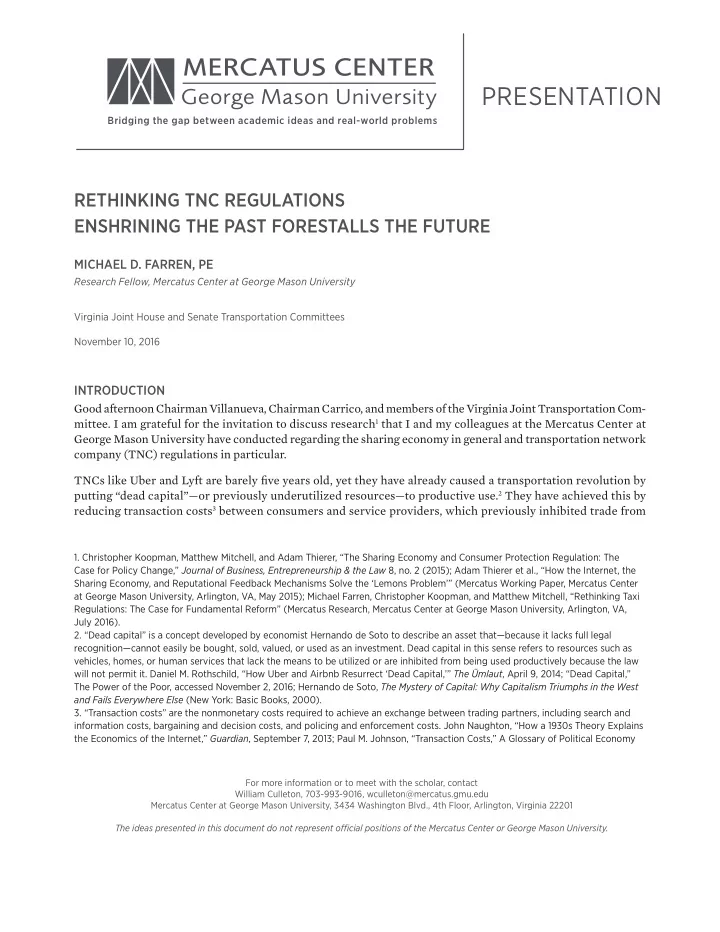

PRESENTATION Bridging the gap between academic ideas and real-world problems RETHINKING TNC REGULATIONS ENSHRINING THE PAST FORESTALLS THE FUTURE MICHAEL D. FARREN, PE Research Fellow, Mercatus Center at George Mason University Virginia Joint House and Senate Transportation Committees November 10, 2016 INTRODUCTION Good afternoon Chairman Villanueva, Chairman Carrico, and members of the Virginia Joint Transportation Com- mittee. I am grateful for the invitation to discuss research 1 that I and my colleagues at the Mercatus Center at George Mason University have conducted regarding the sharing economy in general and transportation network company (TNC) regulations in particular. TNCs like Uber and Lyft are barely fjve years old, yet they have already caused a transportation revolution by putting “dead capital”—or previously underutilized resources—to productive use. 2 They have achieved this by reducing transaction costs 3 between consumers and service providers, which previously inhibited trade from 1. Christopher Koopman, Matthew Mitchell, and Adam Thierer, “The Sharing Economy and Consumer Protection Regulation: The Case for Policy Change,” Journal of Business, Entrepreneurship & the Law 8, no. 2 (2015); Adam Thierer et al., “How the Internet, the Sharing Economy, and Reputational Feedback Mechanisms Solve the ‘Lemons Problem’” (Mercatus Working Paper, Mercatus Center at George Mason University, Arlington, VA, May 2015); Michael Farren, Christopher Koopman, and Matthew Mitchell, “Rethinking Taxi Regulations: The Case for Fundamental Reform” (Mercatus Research, Mercatus Center at George Mason University, Arlington, VA, July 2016). 2. “Dead capital” is a concept developed by economist Hernando de Soto to describe an asset that—because it lacks full legal recognition—cannot easily be bought, sold, valued, or used as an investment. Dead capital in this sense refers to resources such as vehicles, homes, or human services that lack the means to be utilized or are inhibited from being used productively because the law will not permit it. Daniel M. Rothschild, “How Uber and Airbnb Resurrect ‘Dead Capital,’” The Ümlaut , April 9, 2014; “Dead Capital,” The Power of the Poor, accessed November 2, 2016; Hernando de Soto, The Mystery of Capital: Why Capitalism Triumphs in the West and Fails Everywhere Else (New York: Basic Books, 2000). 3. “Transaction costs” are the nonmonetary costs required to achieve an exchange between trading partners, including search and information costs, bargaining and decision costs, and policing and enforcement costs. John Naughton, “How a 1930s Theory Explains the Economics of the Internet,” Guardian , September 7, 2013; Paul M. Johnson, “Transaction Costs,” A Glossary of Political Economy For more information or to meet with the scholar, contact William Culleton, 703-993-9016, wculleton@mercatus.gmu.edu Mercatus Center at George Mason University, 3434 Washington Blvd., 4th Floor, Arlington, Virginia 22201 The ideas presented in this document do not represent offjcial positions of the Mercatus Center or George Mason University.
taking place. This revolution has disrupted not only the established transportation service industry, but also the existing laws and regulations concerning for-hire transportation services. 4 Policymakers now need to critically reexamine statutes and regulations afgecting the transportation service industry to determine which legal rules, if any, are still necessary. 5 In this testimony, I will: 1. Provide an overview of state TNC statutes. 2. Discuss how provisions on entry and licensing costs, public safety concerns, and business model mandates act as barriers to entry and stifme competition. 3. Recommend starting from a blank slate in evaluating new legislation. OVERVIEW OF TNC STATUTES The 39 state TNC statutes enacted between 2014 and 2016 are a mix of boilerplate text and state-specifjc consid- erations. Insurance mandates for TNC operations are perhaps the most similar between states, due to the fact that most states have broadly adopted the “Compromise Model Bill” developed by Uber, Lyft, and a number of insurance companies. 6 However, other aspects of TNC laws are substantially difgerent, such as licensing costs and business model mandates. I categorize the provisions contained in TNC laws according to the following three broad dimensions: 1. Entry and Licensing Costs 2. Public Safety 3. Business Model Mandates 1. ENTRY AND LICENSING COSTS Entry and licensing costs include both monetary fees and nonmonetary procedural costs that TNCs face in obtain- ing and maintaining legal authorization to connect customers with for-hire drivers. The most obvious examples of the monetary costs are application, registration, and renewal fees. Annual licensing fees for the TNC platform fjrms vary widely, ranging from a high of $300,000 in Georgia to a low of $250 in Kentucky. Many states’ licens- ing fees are $5,000 or less. Virginia has one of the highest licensing fees, with an initial application fee of $100,000 and subsequent renewal fees of $60,000. High licensing fees create what economists call a “barrier to entry” for entrepreneurs, thereby protecting established companies from new competition. The result is that established companies enjoy a degree of monopoly power. Protection from competition tends to raise prices, reduce service quality, or decrease the quantity of service ofgered. As my colleague Christopher Koopman has written: Consumers are often left with higher prices, fewer choices, and lower quality service. Barriers to entry mean that incumbent fjrms have little need to focus on satisfying consumer desires; instead, their success depends upon their ability to court regulators and retain regulatory protections. Over time, Terms, accessed November 2, 2016; Carl J. Dahlman, “The Problem of Externality,” Journal of Law & Economics 22, no. 1 (1979): 141–62; R. H. Coase, “The Nature of the Firm,” Economica 4, no. 16 (1937): 386–405. 4. Koopman, Mitchell, and Thierer, “The Sharing Economy and Consumer Protection Regulation”; Thierer et al., “How the Internet, the Sharing Economy, and Reputational Feedback Mechanisms.’” 5. Farren, Koopman, and Mitchell, “Rethinking Taxi Regulations.” 6. Alexander B. Traum, “Sharing Risk in the Sharing Economy: Insurance Regulation in the Age of Uber,” Cardozo Public Law, Policy & Ethics Journal 14 (2016): 531. MERCATUS CENTER AT GEORGE MASON UNIVERSITY 2
Recommend
More recommend